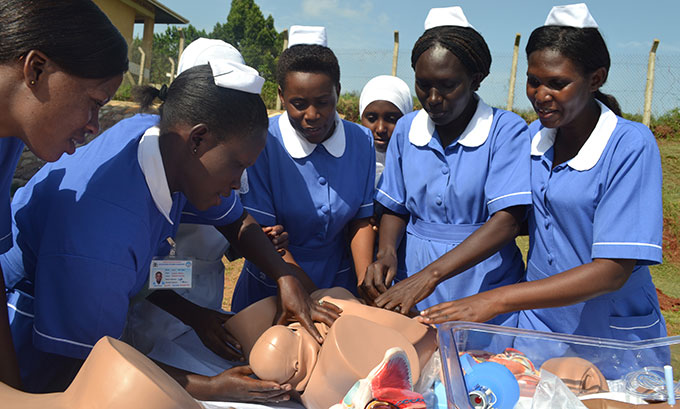
There are a lot of terms used in midwifery, but we are going to look at some of them.
Phototherapy: is the use of light energy to convert the bilirubin molecule in the jaundiced infant skin to a form which can be excreted without conjugation in the liver.
Polyhydramnio: clinical diagnosis of excessive amount of liquor amnii (more than 1500ml at term).
Pica: eating of a substance usually considered inedible.
Hyper emesis Gravidarum: is vomiting during pregnancy sufficient to warrant admission of the woman to hospital.
Lochia: the discharge from the uterus during the puerperium
Linea Nigra: brown or black line of pigmentation in the mid line of the abdominal wall during pregnancy.
Colostrums: is the yellowish fluid expressed from the breast during late pregnancy and before the onset of true lactation.
Antepartum haemorrhage: is bleeding from the birth canal in the period from the 20thweek of gestation to the birth of the baby.
Braxton Hicks Contraction: is the spontaneous painless uterine contraction described originally as a sign of pregnancy.
Abortion: the process by which the product of conception are expelled from the uterus via the birth canal before fetal viability.
Alcohol Syndrome Fetal: is the collection of sign manifests in the new born when the mother has taken excessive amount of alcohol.
Abdominal Gestation: pregnancy occurring outside the uterus and free in the abdominal cavity.
Abruption: it means tearing away from.
Atresia: is the closure or absence of a usual opening or canal .e.g. oesophageal Atresia.
Biopsy: examination of tissues from the living body.
Dystocia: it means difficult labour.
Gestation: it means pregnancy. e.g. Ectopic gestation.
Gravid: it means pregnant.
Gravidarum: pregnant woman.
Hydrorrhoea Gravidarum: a condition in which during the later months of pregnancy, there is discharge from the uterus of clear fluid which may be amniotic.
Menarche: the initial onset of menstruation.
Multigravida: a woman who has been pregnant more than once.
Multipara: a woman who had born more than one child.
Nullipara: a woman who has not given birth to a viable child. She may however have been pregnant before, but had miscarriage or termination of pregnant.
Effacement: it means taking up of cervix.
Vagitus Uterius: the cry of fetus in utero
Terotogen: any agent or drugs believe to cause congenital abnormality. E .g. thalidomideFull
Dilatation: cervix completely open.Involution: returning to normal size after enlargement .e.g. uterus after labour.
Vertex: are between occiput and sinciput.
Rectocele: prolapsed of the rectum into the vagina.
Ectopic Gestation: pregnancy outside the uterus.
Galactorrhoea: excessive flow of milk.
Vernix caseosa: greasy substance of the foetal skin in utero
Lightening: is applied to the sinking or setting of the fetus into the lower pole of the uterus at the 36weeks of pregnancy and this commonly seen in the primigravida.
Erythroblastosis: immature erythrocytes of the new born or the presence of erythroblast in the blood.Asphyxia
Neonatorum: term used to describe the condition of an infant who has been subjected to hypoxia and acidosis during delivery and who fails to breathe following birth.
Cephalhaematoma: a collection of blood beneath the periosteum of a skull bone, limited to that bone by periosteal attachment.
Down syndrome (mongolism): a congenital abnormality characterized by the presence of extra chromosome
Episiotomy: incisions of the perineum and vagina that enlarges the introitus and lessen the curve of the birth canal.
Ergometrine: the active oxytocic principle derived from ergot.
Preterm infant: one born before 36 weeks gestation.
Quickening: when the woman first becomes aware of fetal movement.
Puerperium: the period during which the reproductive organs return to their pregnant condition-usually regarded as an interval of 6 weeks after delivery.
Show: a discharge of mucus and blood at the onset of labour when the cervix dilates and the operculum (cervical mucus plug) fall out.

Comments
Post a Comment